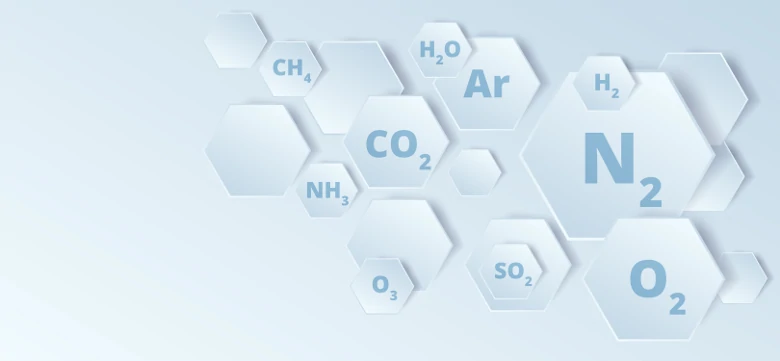Atmosphere And Environment
In this article, we will learn about the atmosphere and environment. These are the learning outcomes:
- Describe the composition by volume of gases present in dry air.
- Name some common air pollutants and state their sources.
- Describe the effects of some air pollutants on health and the environment.
This article is specifically written to meet the requirements of the Upper Secondary Chemistry syllabus in Singapore.
Composition of Air
Air is a mixture of several gases. Since air is a mixture, its composition varies at different times and places.
The pie chart above shows the composition by volume of clean, dry air.
Nitrogen and oxygen are the main gases in air. The rest are noble gases (mainly argon) and carbon dioxide.
Separating Air
The separation of air into its constituent gases is an important process for obtaining nitrogen and oxygen. The gases in the air can be separated by fractional distillation.
Air is first liquefied by cooling and compression. This process is also known as liquefaction. After liquefaction, the air is called liquid air.
Image Credit: Chemistry Stack Exchange - chemistry.stackexchange.com
The liquid air is passed into the fractionating column, where the different constituents are separated based on the difference in their boiling points.
Nitrogen is distilled over first because it has the lowest boiling point (-196º C), while oxygen is distilled over last because it has the highest boiling point (-183º C).
Question 1:
Which of the following correctly shows the industrial use of argon and its percentage abundance in clean and dry air?
Industrial use of argon % abundance in dry air
- to fill hot air balloons 0.03%
- to fill hot air balloons 0.97%
- used as an inert gas shield in arc welding and cutting 0.03%
- used as an inert gas shield in arc welding and cutting 0.97%
Solution:
(D)
Explanation:
Argon is a noble gas which is unreactive. Noble gases are mostly used to provide an inert atmosphere. Hence, argon is commonly used to prevent the metal from reacting with the atmosphere during welding or cutting.
The percentage of noble gases (mainly argon) in air is about 0.97%.
Common Air Pollutants
What is air pollution?
Air pollution is a condition where air contains a high concentration of chemicals that may have harmful effects on living organisms and the environment.
Image Credit: Chris LeBoutillier - unsplash.com
What are the common air pollutants?
- Carbon monoxide (CO)
- Sulfur dioxide (SO2)
- Oxides of nitrogen (NO/NO2)
- Unburnt hydrocarbon (CxHy)
- Methane (CH4)
- Ozone (O3)
Carbon Monoxide ( CO )
- Characteristics: colourless and odourless
- Source: incomplete combustion of carbon-containing substances (e.g. petrol, fossil fuels) in power stations and vehicles.
Incomplete combustion refers to the burning of fuel in a limited supply of air (oxygen).
For Example:
Incomplete combustion of methane gas will result in the production of carbon monoxide and carbon particles (in the form of soot).
\(4CH_4 + 5O_2 \; \xrightarrow[\qquad\qquad]{} \; 2CO + 8H_2O + 2C + \text{ heat energy}\)
Image Credit: Encyclopædia Britannica - britannica.com
- Effects:
- It combines irreversibly with haemoglobin in the red blood cells to form carboxyhaemoglobin, reducing the ability of the red blood cells to carry oxygen to different parts of the body.
- Headaches, fatigue
- Breathing difficulties
- Loss of consciousness, heart damage
- Death
Sulfur Dioxide ( SO2 )
- Characteristics: colourless and pungent
- Sources:
- Combustion of fossil fuels in power stations and factories. Fossil fuels contain sulfur. When burnt, sulfur is converted into sulfur dioxide.
\(S + O_2 \;\xrightarrow[\qquad\qquad]{} \; SO2\)
- Volcanic activities
Image Credit: Michal Pech - unsplash.com
Image Credit: Tanya Grypachevskaya - unsplash.com
Oxides of Nitrogen ( NO / NO2 )
- Sources:
- Internal combustion in engines of vehicles.
In the car engine, where the temperatures are very high, oxygen and nitrogen will react to form nitrogen monoxide. Nitrogen monoxide reacts with more oxygen to form nitrogen dioxide.
\(N_2 + O_2 \xrightarrow[\qquad\qquad]{} 2NO\)
\(2NO + O_2 \;\xrightarrow[\qquad\qquad]{}\; 2NO_2\)
- Lightning activities: When lightning strikes, a large amount of heat energy is released. This causes oxygen and nitrogen in the air to react and form oxides of nitrogen.
Image Credit: Michael D - unsplash.com
Sulfur Dioxide and Oxides of Nitrogen
These two air pollutants have similar effects on living organisms and the environment.
- Effects:
- Eye and lung irritation
- Inflammation of the lungs at high levels
- Breathing difficulties
- React with rainwater and oxygen to form acid rain
Acid Rain
Acid rain is formed when sulfur dioxide and nitrogen dioxide react with water in the atmosphere.
For Sulfur Dioxide:
\(SO_2 (g) + H_2O (l) \;\xrightarrow[\qquad\qquad]{}\; H_2SO_3 (aq)\)
Sulfur dioxide dissolves in water to form sulfurous acid.
\(2H_2SO_3 (aq) + O_2 (g) \;\xrightarrow[\qquad\qquad]{}\; 2H_2SO_4 (aq)\)
Sulfurous acid is oxidised by oxygen in the air to form sulfuric acid.
For nitrogen oxide:
\(4NO_2 (g) + O_2 (g) + 2H_2O (l) \;\xrightarrow[\qquad\qquad]{}\; 4HNO_3 (aq)\)
Nitrogen oxide will react with oxygen and water in the air to form nitric acid.
What are the effects of acid rain?
- Acid rain lowers the pH value of water bodies such as lakes and streams, causing the aquatic plants and animals to die.
- Acid rain reacts with structures and buildings made up of metals, marble and limestone, causing them to be damaged.
- It promotes the leeching of nutrients from the soil which affects the healthy growth of plants.
Unburnt Hydrocarbons ( CxHy )
- Sources:
- From internal combustion engines of vehicles
- From chemical plants
- Effects:
- Causes cancer (carcinogenic)
Image Credit: Patrick Hendry - unsplash.com
Methane ( CH4 )
-
Sources:
- Decay of plant and animal matter
- Decay of rubbish in landfills
- Digestion of food in sheep and cows
- Effect:
- Methane is a greenhouse gas. Excessive build-up of greenhouse gases will lead to an increase in the amount of infrared radiation being trapped in the atmosphere. This results in an increase in the Earth’s average temperature, also known as global warming.
Ozone ( O3 )
-
Source:
- Formed when nitrogen dioxide in the air reacts with unburnt hydrocarbons in the presence of sunlight.
- Effects:
- Forms photochemical smog which irritates the eyes and lungs
- Breathing difficulties
Image Credit: Alex Gindin - unsplash.com
Question 2:
Which of the following substances is produced during the combustion of fossil fuels?
- carbon dioxide
- soot
- sulfur dioxide
- water
Solution:
(C) sulfur dioxide
Explanation:
Fossil fuels contain sulfur. When burnt, sulfur reacts with oxygen to produce sulfur dioxide.
Question 3:
Which of the following explains the poisonous nature of carbon monoxide?
- colourless and odourless
- combines with oxygen in the haemoglobin in the red blood cells
- corrosive to lung tissues
- forms strong bonds with haemoglobin in the red blood cells
Solution:
(D) forms strong bonds with haemoglobin in the red blood cells
Explanation:
Carbon monoxide combines irreversibly with haemoglobin in the red blood cells to form carboxyhaemoglobin, reducing the ability of the red blood cells to carry oxygen to different parts of the body.
Question 4:
Which of the following pairs of pollutants brings about the most damage to buildings made of limestone and metal?
- carbon monoxide and nitrogen monoxide
- chlorofluorocarbons and ozone
- methane and sulfur dioxide
- sulfur dioxide and oxides of nitrogen
Solution:
(D) sulfur dioxide and oxides of nitrogen
Explanation:
Sulfur dioxide and oxides of nitrogen react with water in the atmosphere to form acid rain, which corrodes buildings made of limestone and metal.
Conclusion
In the article, we learned to describe the composition by volume of gases present in dry air. We also learned to name some common air pollutants and state their sources. In addition, we also described the effects of some air pollutants on health and the environment. Practice the questions in the article to understand more about the topics.
Keep Learning! Keep Improving!


 SG
SG  VN
VN 

















